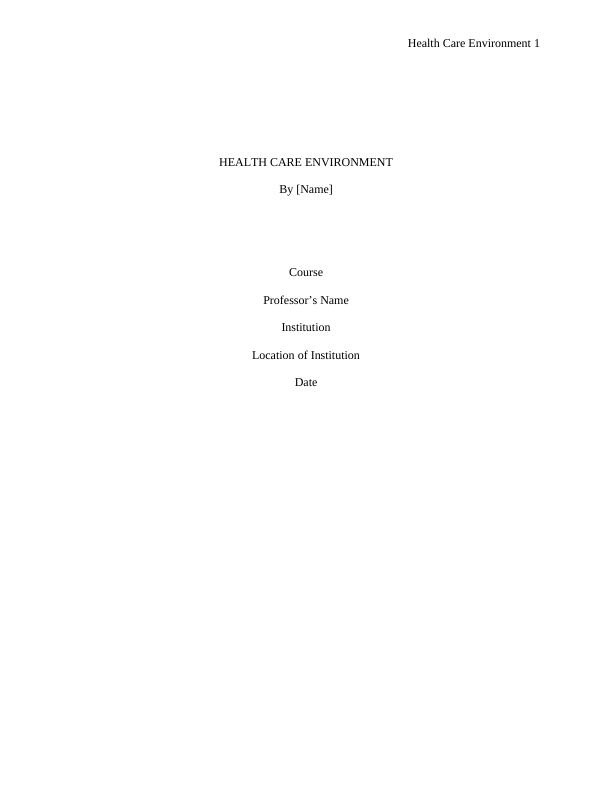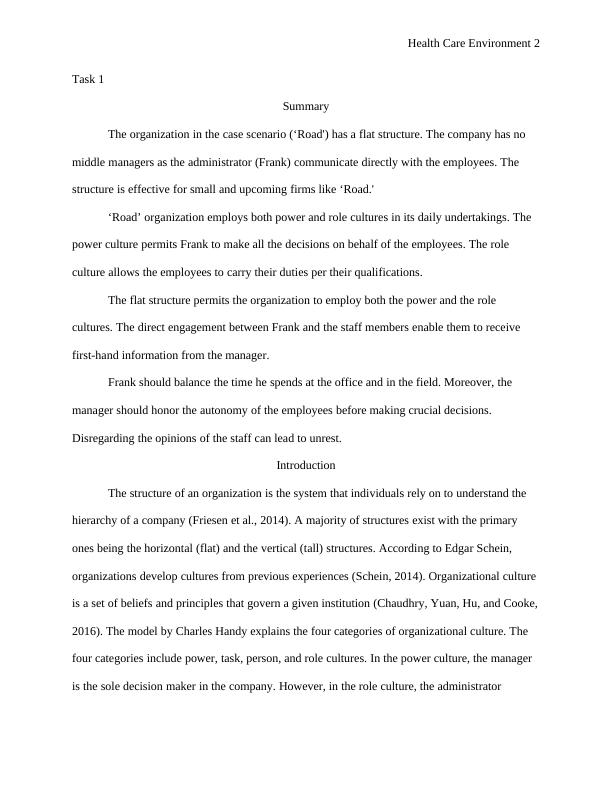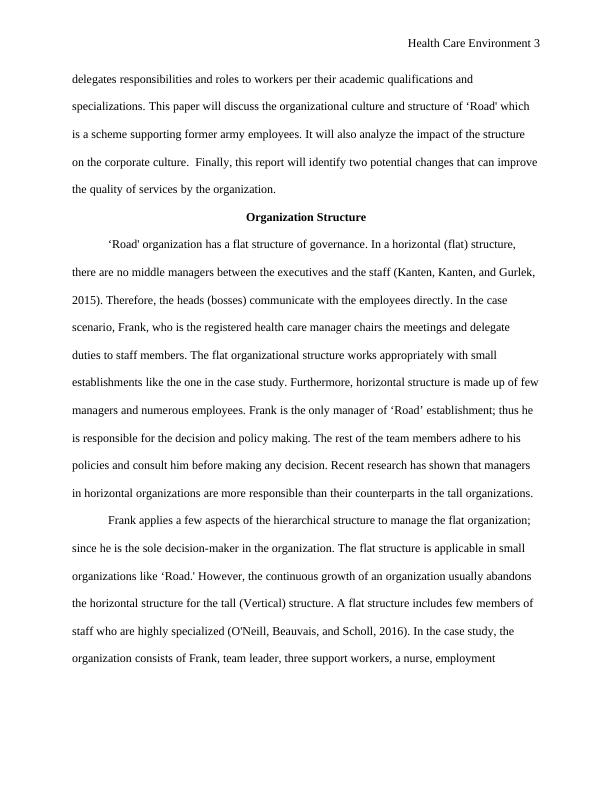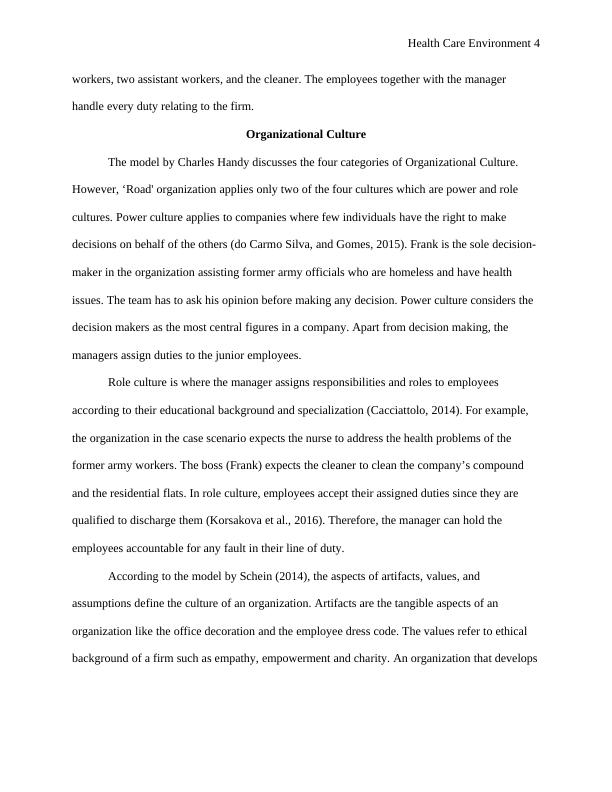Ask a question from expert
MOD004054 - Healthcare Environment
12 Pages3122 Words182 Views
Healthcare Environment (MOD004054)
Added on 2021-09-23
MOD004054 - Healthcare Environment
Healthcare Environment (MOD004054)
Added on 2021-09-23
BookmarkShareRelated Documents
Health Care Environment 1
HEALTH CARE ENVIRONMENT
By [Name]
Course
Professor’s Name
Institution
Location of Institution
Date
HEALTH CARE ENVIRONMENT
By [Name]
Course
Professor’s Name
Institution
Location of Institution
Date

Health Care Environment 2
Task 1
Summary
The organization in the case scenario (‘Road') has a flat structure. The company has no
middle managers as the administrator (Frank) communicate directly with the employees. The
structure is effective for small and upcoming firms like ‘Road.'
‘Road’ organization employs both power and role cultures in its daily undertakings. The
power culture permits Frank to make all the decisions on behalf of the employees. The role
culture allows the employees to carry their duties per their qualifications.
The flat structure permits the organization to employ both the power and the role
cultures. The direct engagement between Frank and the staff members enable them to receive
first-hand information from the manager.
Frank should balance the time he spends at the office and in the field. Moreover, the
manager should honor the autonomy of the employees before making crucial decisions.
Disregarding the opinions of the staff can lead to unrest.
Introduction
The structure of an organization is the system that individuals rely on to understand the
hierarchy of a company (Friesen et al., 2014). A majority of structures exist with the primary
ones being the horizontal (flat) and the vertical (tall) structures. According to Edgar Schein,
organizations develop cultures from previous experiences (Schein, 2014). Organizational culture
is a set of beliefs and principles that govern a given institution (Chaudhry, Yuan, Hu, and Cooke,
2016). The model by Charles Handy explains the four categories of organizational culture. The
four categories include power, task, person, and role cultures. In the power culture, the manager
is the sole decision maker in the company. However, in the role culture, the administrator
Task 1
Summary
The organization in the case scenario (‘Road') has a flat structure. The company has no
middle managers as the administrator (Frank) communicate directly with the employees. The
structure is effective for small and upcoming firms like ‘Road.'
‘Road’ organization employs both power and role cultures in its daily undertakings. The
power culture permits Frank to make all the decisions on behalf of the employees. The role
culture allows the employees to carry their duties per their qualifications.
The flat structure permits the organization to employ both the power and the role
cultures. The direct engagement between Frank and the staff members enable them to receive
first-hand information from the manager.
Frank should balance the time he spends at the office and in the field. Moreover, the
manager should honor the autonomy of the employees before making crucial decisions.
Disregarding the opinions of the staff can lead to unrest.
Introduction
The structure of an organization is the system that individuals rely on to understand the
hierarchy of a company (Friesen et al., 2014). A majority of structures exist with the primary
ones being the horizontal (flat) and the vertical (tall) structures. According to Edgar Schein,
organizations develop cultures from previous experiences (Schein, 2014). Organizational culture
is a set of beliefs and principles that govern a given institution (Chaudhry, Yuan, Hu, and Cooke,
2016). The model by Charles Handy explains the four categories of organizational culture. The
four categories include power, task, person, and role cultures. In the power culture, the manager
is the sole decision maker in the company. However, in the role culture, the administrator

Health Care Environment 3
delegates responsibilities and roles to workers per their academic qualifications and
specializations. This paper will discuss the organizational culture and structure of ‘Road' which
is a scheme supporting former army employees. It will also analyze the impact of the structure
on the corporate culture. Finally, this report will identify two potential changes that can improve
the quality of services by the organization.
Organization Structure
‘Road' organization has a flat structure of governance. In a horizontal (flat) structure,
there are no middle managers between the executives and the staff (Kanten, Kanten, and Gurlek,
2015). Therefore, the heads (bosses) communicate with the employees directly. In the case
scenario, Frank, who is the registered health care manager chairs the meetings and delegate
duties to staff members. The flat organizational structure works appropriately with small
establishments like the one in the case study. Furthermore, horizontal structure is made up of few
managers and numerous employees. Frank is the only manager of ‘Road’ establishment; thus he
is responsible for the decision and policy making. The rest of the team members adhere to his
policies and consult him before making any decision. Recent research has shown that managers
in horizontal organizations are more responsible than their counterparts in the tall organizations.
Frank applies a few aspects of the hierarchical structure to manage the flat organization;
since he is the sole decision-maker in the organization. The flat structure is applicable in small
organizations like ‘Road.' However, the continuous growth of an organization usually abandons
the horizontal structure for the tall (Vertical) structure. A flat structure includes few members of
staff who are highly specialized (O'Neill, Beauvais, and Scholl, 2016). In the case study, the
organization consists of Frank, team leader, three support workers, a nurse, employment
delegates responsibilities and roles to workers per their academic qualifications and
specializations. This paper will discuss the organizational culture and structure of ‘Road' which
is a scheme supporting former army employees. It will also analyze the impact of the structure
on the corporate culture. Finally, this report will identify two potential changes that can improve
the quality of services by the organization.
Organization Structure
‘Road' organization has a flat structure of governance. In a horizontal (flat) structure,
there are no middle managers between the executives and the staff (Kanten, Kanten, and Gurlek,
2015). Therefore, the heads (bosses) communicate with the employees directly. In the case
scenario, Frank, who is the registered health care manager chairs the meetings and delegate
duties to staff members. The flat organizational structure works appropriately with small
establishments like the one in the case study. Furthermore, horizontal structure is made up of few
managers and numerous employees. Frank is the only manager of ‘Road’ establishment; thus he
is responsible for the decision and policy making. The rest of the team members adhere to his
policies and consult him before making any decision. Recent research has shown that managers
in horizontal organizations are more responsible than their counterparts in the tall organizations.
Frank applies a few aspects of the hierarchical structure to manage the flat organization;
since he is the sole decision-maker in the organization. The flat structure is applicable in small
organizations like ‘Road.' However, the continuous growth of an organization usually abandons
the horizontal structure for the tall (Vertical) structure. A flat structure includes few members of
staff who are highly specialized (O'Neill, Beauvais, and Scholl, 2016). In the case study, the
organization consists of Frank, team leader, three support workers, a nurse, employment

Health Care Environment 4
workers, two assistant workers, and the cleaner. The employees together with the manager
handle every duty relating to the firm.
Organizational Culture
The model by Charles Handy discusses the four categories of Organizational Culture.
However, ‘Road' organization applies only two of the four cultures which are power and role
cultures. Power culture applies to companies where few individuals have the right to make
decisions on behalf of the others (do Carmo Silva, and Gomes, 2015). Frank is the sole decision-
maker in the organization assisting former army officials who are homeless and have health
issues. The team has to ask his opinion before making any decision. Power culture considers the
decision makers as the most central figures in a company. Apart from decision making, the
managers assign duties to the junior employees.
Role culture is where the manager assigns responsibilities and roles to employees
according to their educational background and specialization (Cacciattolo, 2014). For example,
the organization in the case scenario expects the nurse to address the health problems of the
former army workers. The boss (Frank) expects the cleaner to clean the company’s compound
and the residential flats. In role culture, employees accept their assigned duties since they are
qualified to discharge them (Korsakova et al., 2016). Therefore, the manager can hold the
employees accountable for any fault in their line of duty.
According to the model by Schein (2014), the aspects of artifacts, values, and
assumptions define the culture of an organization. Artifacts are the tangible aspects of an
organization like the office decoration and the employee dress code. The values refer to ethical
background of a firm such as empathy, empowerment and charity. An organization that develops
workers, two assistant workers, and the cleaner. The employees together with the manager
handle every duty relating to the firm.
Organizational Culture
The model by Charles Handy discusses the four categories of Organizational Culture.
However, ‘Road' organization applies only two of the four cultures which are power and role
cultures. Power culture applies to companies where few individuals have the right to make
decisions on behalf of the others (do Carmo Silva, and Gomes, 2015). Frank is the sole decision-
maker in the organization assisting former army officials who are homeless and have health
issues. The team has to ask his opinion before making any decision. Power culture considers the
decision makers as the most central figures in a company. Apart from decision making, the
managers assign duties to the junior employees.
Role culture is where the manager assigns responsibilities and roles to employees
according to their educational background and specialization (Cacciattolo, 2014). For example,
the organization in the case scenario expects the nurse to address the health problems of the
former army workers. The boss (Frank) expects the cleaner to clean the company’s compound
and the residential flats. In role culture, employees accept their assigned duties since they are
qualified to discharge them (Korsakova et al., 2016). Therefore, the manager can hold the
employees accountable for any fault in their line of duty.
According to the model by Schein (2014), the aspects of artifacts, values, and
assumptions define the culture of an organization. Artifacts are the tangible aspects of an
organization like the office decoration and the employee dress code. The values refer to ethical
background of a firm such as empathy, empowerment and charity. An organization that develops

End of preview
Want to access all the pages? Upload your documents or become a member.
Related Documents
Impact of Hierarchical Structure on Organizational Culture in Health Care Environmentlg...
|8
|1857
|92
Behaviour of Employees and Staff of Enterprise Car Rental and City Collegelg...
|13
|3890
|372
Behavior of People Working in City Collagelg...
|14
|4062
|54
Assignment On Organizational Structure & Culture | GSK Vs PFIZER INClg...
|14
|3968
|75
Organisation and Behaviour TABLE OF CONTENTSlg...
|17
|4271
|250
Impact of Leadership Styles on Business Activities and Structurelg...
|16
|3609
|370